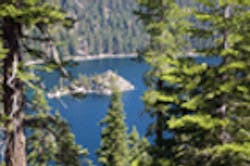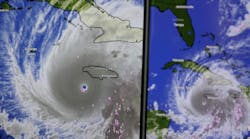Is Alumina a Solution?
Dirty stormwater is like acid eating away at the clarity of Lake Tahoe. Could a chemical help the situation? Engineers are exploring the concept, according to a recent story in the Tahoe Daily Tribune.
Storms hit and send rain or snowmelt over polluted streets and into drains that flow into the lake. To stem the tide of damage, California water quality officials want to see stormwater cleaner by 2008.
Caltrans, the state transportation agency that maintains the largest roads on the California side of Lake Tahoe Basin, has spent more than $7 million over the past five years to figure out how to better neutralize stormwater and meet standards set by the state.
Rock trenches and retention basins, installed throughout the basin since the mid-1990s to clean stormwater, allow polluting sediments time to settle out and be absorbed into land. They don't, however, work well enough to meet the quality standard set for 2008.
"We're looking at the chemical treatment of water to enhance the settling of sediment," said Kevin Murphy, an engineer with the Office of Water Programs at California State University, Sacramento, who is working with Caltrans on the stormwater problem. "The chemicals react with the sediment causing (things) to thicken and drop to the bottom of the settling basin."
Alumina, an expensive chemical used to remove arsenic from drinking water, might be the answer. After $4.5 million worth of testing at Caltrans' stormwater laboratory in Meyers, alumina - tiny white chips of oxygenated aluminum - is the substance engineers say looks promising.
A three-year study, which began October 2003, is under way to determine how the chemical performs in basins along Highway 50 near the Lake Tahoe Airport.
The alumina was heated to 1,000 degrees before it was spread a foot deep in two spots along the highway. The heat expands the chips so they become porous and have room to absorb sediments. Caltrans purchased 42,000 lb of alumina at about $1,000 per lb for the study.
Other pilot projects involving the chemical are being designed for the Placer County portion of the basin, according to Mark Keisler, a Caltrans transportation engineer. "It is still in development phase, but it shows a lot of promise," Murphy said. "We still have to figure out if it's feasible. Not just to treat runoff, but whether the final cost is reasonable."
The Lahontan Regional Water Quality Control Board is the state agency that wants to see cleaner stormwater by 2008. Considering how much more time Caltrans needs to perform its stormwater studies, the agency last week discussed whether it is realistic to ask Caltrans to meet the 2008 deadline along all the road it maintains in the basin, said Doug Smith, a senior engineering geologist at Lahontan.
Smith said Lahontan may ask the transportation agency to identify and address only the biggest problem areas for stormwater by the deadline.
Since it operates in a different state, the Nevada Department of Transportation does not have to meet stormwater standards as strict as those set for Caltrans. But there are stormwater standards set by the Tahoe Regional Planning Agency for the entire basin that NDOT is working toward attaining through standard methods.
Source: tahoedailytribune.com


